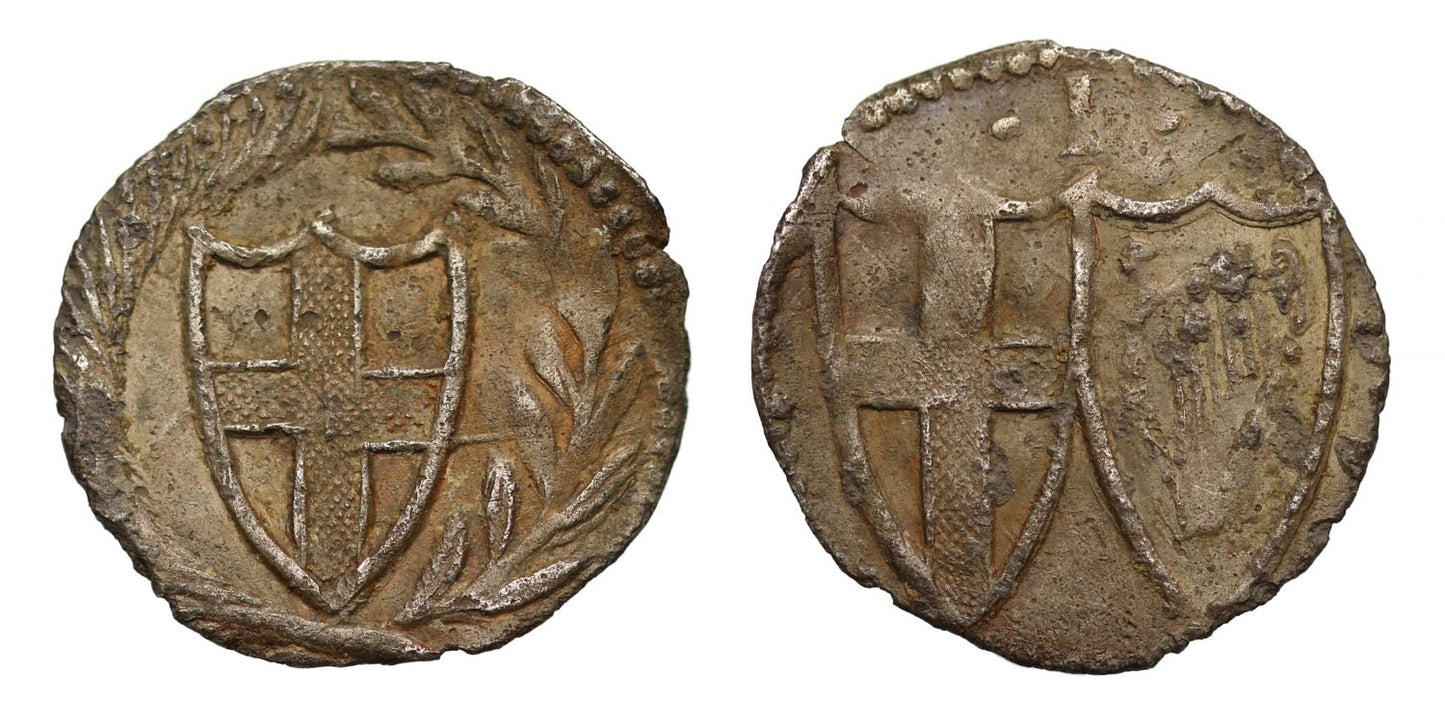FAQs
What makes a coin valuable?
I have coins to sell, what’s the next step?
How will my purchases be shipped?
What happens if I’m not entirely happy with my purchase?
Commonwealth silver Penny
Commonwealth (1649-60), silver Penny, Tower Mint London, English shield within laurel and palm branches, outer beaded border surrounding, rev. struck en medaille, English and Irish shields side by side, value .I. above, outer beaded border surrounding, weight 0.42g (N.2729; S.3222). Toned, quite well struck for this small coin, good very fine for issue, though a little weaker on reverse.
The English Civil War with the parliamentarian New Model Army of roundheads was eventually triumphant over the cavalier Royalist soldiers of Charles I leading to the trial and conviction of the King, who absolutely believed in his divine right to rule, on charges of treason with his death warrant signed, he was beheaded on 30th January 1649 outside the Banqueting House in Whitehall London. The Commonwealth of England was founded at this interregnum juncture at first governed by a Rump Parliament which came into being after Thomas Pride's Purge of the Long Parliament on 5th December 1648 which barred hostile members to the New Model way from the House of Commons with 180 out of 470 members denied access, with 45 of those arrested. Oliver Cromwell did not want the King to end up on trial, but once Charles refused to order the Duke of Ormond in Ireland to end negotiations with the Irish confederacy to prevent war in Ireland, the King's fate was sealed and he went for trial for treason, conviction by only 52 judges in attendance out of a total of 135 and subsequent execution. After this regicide there followed two years of economic depression with a risk of invasion from Scotland, where they considered Charles II King, and high taxes with puritan rules. The Rump Parliament was dismissed on 20th April 1653 and the new Protectorate established with Oliver Cromwell as Lord Protector and the army now rules with the help of Thomas Harrison. An assembly was nominated with what became known as the Barebones Parliament made up of lesser gentry including 40 Radicals and Fifth Monarchists who wanted to change common law and religious values, 60 Moderates who wanted to improve things and 40 conservatives wanting to keep the current status quo, but they were all much divided over key issues and was over by December of 1653. The interregnum period ran through three Protectorate parliaments, the first in 1654 which dissolved later that same year as the proposed bills were never passed. A second in 1657 where Cromwell refused the title of King but continued as Lord Protector which was made a hereditary position so it would pass to his son Richard which it did on 3rd September 1658 when Oliver died aged 59. Richard had never been an army man and he lost control of the Major-Generals that Oliver had commanded. The third and final Parliament was seated on 27th January 1659 and as it became apparent that Richard could not control the army he dissolved it but was removed from power and a Rump Parliament reinstalled, however it was all in vain and an ascent back towards the restoration of the crown of England under Charles II by the Declaration of Breda of 4th April 1660. The coinage of the Commonwealth plain in its nature, were the first coins to carry the legends in English language.
Capital City London upon the River Thames following Roman occupation, minted some of the earliest Saxon coins with gold Thrymsas and silver denarii with a "Londuniu" signature. Mercian Kings beginning with Offa minted coins there, but the first coin to actually say City of London upon it is the unique Ludica portrait Penny that was found in 2016, followed by subsequent coins of Ecgberht. In 871 the Danes wintered in London for the first time but was King Alfred of Wessex who settled and fortified the capital circa 880 to resist further invasions. Edward the Elder incorporated the City in Wessex in 911 and it resisted a major attack in the reign of Aethelred II in 1009. However, London submitted to the Danish Swein in 1013, but three years later the citizens accepted Eadmund Ironside as King and resisted a siege by Canute.
Later unsettled times occurred in the anarchy period of the reign of King Stephen, remaining loyal to the King except for a few months in 1141 when Empress Matilda was admitted but within a short time expelled. Coinage activity here has been mostly constant throughout history from the Romans until the reign of our current Queen and only moving out to Wales from 1969.
Provenance:
Ex Paul Revell, York Coin Fair, January 2019.
Ex Collection of an English Doctor part III, Sovereign Rarities fixed price list online September 2022.
FAQs
What makes a coin valuable?
I have coins to sell, what’s the next step?
How will my purchases be shipped?
What happens if I’m not entirely happy with my purchase?













